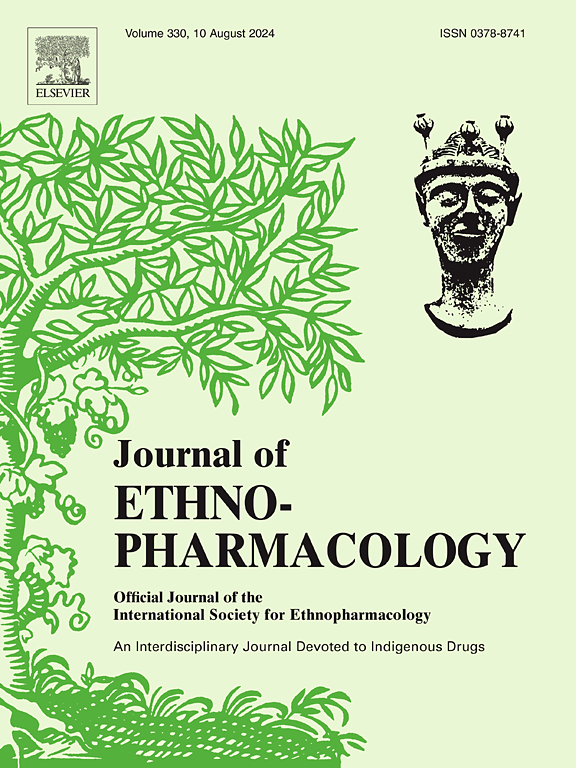Xihuang pill suppressed primary liver cancer growth by downregulation of AFP and YAP signaling
IF 4.8
2区 医学
Q1 CHEMISTRY, MEDICINAL
引用次数: 0
Abstract
Ethnopharmacological relevance
Xihuang Pill (XHP) is a traditional Chinese medicine formula that was originally used to treat malignant ulcers. Recent studies revealed its therapeutic effects on various malignant tumors. However, its potential efficacy and mechanisms in primary liver cancer (PLC) were not thoroughly investigated.
Aim of the study
This study aimed to elucidate the efficacy and potential mechanisms of XHP in the treatment of PLC.
Methods
An orthotopic PLC mice model was established adopting hydrodynamic tail vein injection method. Human liver cancer cell lines and organoids were utilized to assess the effect of XHP in vitro. The expressions of alpha-fetoprotein (AFP) and Yes-associated protein (YAP) were evaluated with western blotting. The mRNA expressions of YAP downstream targets were detected with qRT-PCR. Data from Liver Hepatocellular Carcinoma Collection of the Cancer Genome Atlas (TCGA-LIHC) were extracted to identify the potential targets of HCC. The major active components of XHP methanol extract and XHP medicated serum were detected by UHPLC-MS/MS. Human liver cancer cell lines were used to assess the efficacy and potential mechanisms of these active components in XHP in vitro. Finally, molecular docking was conducted to predict the binding affinities of XHP's active components with AFP and YAP.
Results
XHP inhibited PLC tumor growth in the mice model with decreased AFP and Ki-67 index. In vitro, XHP suppressed the proliferation and migration of liver cancer cell lines in a time- and dose-dependent manner. Furthermore, even with a low concentration (5 mg/mL), XHP paralyzed the growth of PLC organoids derived from patients. Mechanistically, XHP downregulated the expression of AFP and YAP signaling in vitro and in vivo. UHPLC-MS/MS analysis identified 25 active components in XHP medicated serum. Among them, certain active compounds suppressed PLC cell proliferation and downregulated AFP and YAP signaling, suggesting their therapeutic potentials in PLC. Molecular docking indicated that several components in XHP exhibited strong binding affinities with both AFP and YAP.
Conclusion
XHP inhibited PLC growth by suppressing AFP and YAP signaling. This study provides an experimental basis for XHP application in PLC treatment.

西黄丸通过下调AFP和YAP信号通路抑制原发性肝癌的生长
西黄丸(XHP)是一种传统的中药配方,最初用于治疗恶性溃疡。近年来的研究显示其对多种恶性肿瘤有治疗作用。然而,其在原发性肝癌(PLC)中的潜在疗效和机制尚未得到充分研究。本研究旨在阐明XHP治疗PLC的疗效及其潜在机制。方法采用水动力尾静脉注射法建立原位PLC小鼠模型。利用人肝癌细胞系和类器官体外评价XHP的作用。western blotting检测甲胎蛋白(AFP)和yes相关蛋白(YAP)的表达。采用qRT-PCR检测YAP下游靶点mRNA表达。从肝癌基因组图谱(TCGA-LIHC)中提取数据以确定HCC的潜在靶点。采用UHPLC-MS/MS检测XHP甲醇提取物和XHP给药血清的主要有效成分。以人肝癌细胞株为实验对象,对XHP活性成分的体外作用机制进行了研究。最后进行分子对接,预测XHP活性成分与AFP和YAP的结合亲和力。结果xhp抑制小鼠PLC肿瘤生长,降低AFP和Ki-67指数。XHP在体外对肝癌细胞系的增殖和迁移具有时间和剂量依赖性。此外,即使在低浓度(5mg /mL)下,XHP也会使来自患者的PLC类器官的生长瘫痪。在机制上,XHP在体外和体内下调AFP和YAP信号的表达。UHPLC-MS/MS分析鉴定出XHP给药血清中25种有效成分。其中,某些活性化合物抑制PLC细胞增殖,下调AFP和YAP信号,提示其在PLC中的治疗潜力。分子对接表明,XHP中的一些成分与AFP和YAP都表现出很强的结合亲和力。结论xhp通过抑制AFP和YAP信号通路抑制PLC生长。本研究为XHP在PLC处理中的应用提供了实验依据。
本文章由计算机程序翻译,如有差异,请以英文原文为准。
求助全文
约1分钟内获得全文
求助全文
来源期刊

Journal of ethnopharmacology
医学-全科医学与补充医学
CiteScore
10.30
自引率
5.60%
发文量
967
审稿时长
77 days
期刊介绍:
The Journal of Ethnopharmacology is dedicated to the exchange of information and understandings about people''s use of plants, fungi, animals, microorganisms and minerals and their biological and pharmacological effects based on the principles established through international conventions. Early people confronted with illness and disease, discovered a wealth of useful therapeutic agents in the plant and animal kingdoms. The empirical knowledge of these medicinal substances and their toxic potential was passed on by oral tradition and sometimes recorded in herbals and other texts on materia medica. Many valuable drugs of today (e.g., atropine, ephedrine, tubocurarine, digoxin, reserpine) came into use through the study of indigenous remedies. Chemists continue to use plant-derived drugs (e.g., morphine, taxol, physostigmine, quinidine, emetine) as prototypes in their attempts to develop more effective and less toxic medicinals.
 求助内容:
求助内容: 应助结果提醒方式:
应助结果提醒方式:


